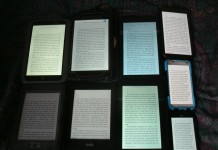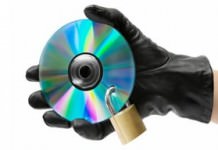 What if the IDPF gave a standards party and no one came—or at least got awfully distracted by proprietary competition from Microsoft and Amazon?
What if the IDPF gave a standards party and no one came—or at least got awfully distracted by proprietary competition from Microsoft and Amazon?
Suppose Amazon were selling a reader gizmo that used the proprietary Mobipocket format.
What-if might soon be reality, in line with earlier hints about Amazon’s Kindle prototype or similar machines (photo is just of a prototype—uglier than the real Amazon Reader, I’d hope).
Jim Milliot of Publishers Weekly reports from the London Book Fair:
Amazon has been previewing its e-reader to publishers both in the U.S. and U.K.—HarperCollins UK CEO Victoria Barnsley mentioned the reader at yesterday’s LBF seminar on green publishing—for months, although it has declined to comment on its existence to the press. According to publishers who have seen the player, the reader is a step up from the Sony Reader which was introduced last year. The screen quality is reportedly as sharp as Sony, but the Amazon device has better functionality, and, as should be expected from the e-tailer, a first rate e-commerce option. Amazon is expected to release the reader this spring, although the exact timing may depend on how fast it can develop a critical mass of titles.
Expected price? Perhaps $400. Amazon may well be able to charge more than Sony’s $350—since I expect many more titles to be offered. Remember, Amazon controls the Mobipocket format. It’s an existing choice vastly more popular than Sony’s BBeB, and, of course, readers of this blog know of Amazon’s efforts to herd publishers into Mobipocket. Hey, better Mobipocket—which runs on my PDAs and the TeleCybook—than BBeB! Still better, of course, would be a universal standard that everyone accepted.
Oh, but what about Adobe? I hope that Bill McCoy and friends are indeed serious about standards, and if Sony can join them and implement the IDPF approach in the Sony Reader, maybe the fight against Amazon will be a little less hopeless. While OpenReader is better than the IDPF standard, the latter is preferable to no standard at all for DRMed books. Of courses, it remains to be seen if Adobe and friends can deal with the D word, and whether Adobe, Sony and the IDPF can achieve interoperability in that area. If not, then the eBabel Tower will loom just as tall and sturdy as ever, unless publishers wise up about DRM.
Some Google successes
In separate news, Jim reports that U.K. resistance to Google’s book search program has waned somewhat. He also references Google’s Online Access program, through which customers can buy or rent books online. Problem is, we’re still in E-Book Museum Land, as I understand it. Last I knew, you wouldn’t be able to download your own files for safekeeping and use in locations beyond WiFi range. Maybe if the IDPF can do a decent standards act, it can yet draw the interest of Google and the do-no-evil people can allow people to own their book purchases for real.
A horror story from a more or less orphaned consumer: Me
Guaranteeing continued enjoyment of a purchase, or access to a service, is of no small interest to me. Guess what. I bought an HP Pavilion computer with a CompUSA service plan, thinking that the closest store would continue to be 2 miles away. Instead CompUSA pulled out of Alexandria, VA, and now the nearest store is perhaps 40 miles away in Columbia, Maryland. And then corporations wonder why we consumers don’t trust them? Hey, Sony. There’s a reason why I’m so bloody suspicious of your proprietary approach. No ideology, just practicality. I still remember how you abandoned the Clie PDA line, and as I see it, any publishers who relies too heavily on BBeB will be a damned fool. At least one of the big publishing conglomerates feels the same way, and I suspect that others do, too. Let’s hope consumers are just as smart and will keep making uppity noises about the dead-end BBeB format, which Adobe’s Bill McCoy has suggested will be eclipsed by a nonproprietary XML-based standard—well, to be exact, the IDPF’s. Or will it? What if the true victors are Microsoft and Amazon? And in the end? A Microzon standard?

































You’re lucky, CompUSA closed all 4 of the Minnesota stores, the closest one for me now is 5 hours away in Des Moines, IA.
Don’t expect me to be buying ebooks from Amazon anytime soon, when Mobipocket doesn’t have Mac or Linux readers. I doubt that I’m willing to buy any dedicated ebook reader that can’t be collapsed into the form factor of a large pen (2 cm diameter, 15-18 cm long), although I do read from my Treo 680 smartphone.
Two different PR strategies. Sony hyped its reader 8-10 months before actual release. Amazon has done no PR at all. Maybe they’re not anywhere near ready?
Very exciting news. A reader with the ability to read Mobipocket would be a real boon. All my book reading is done on this format on a Palm TX or Nokia e62. I’d love to have a big screen Mobipocket reader.
David, why are you referring to Microsoft?
They do have an ebook format but I doubt that it would be popular.
In my opinion they’ll just wait until someone figures out how to have a successful product and then they’ll copy it.
But, Tamas, does Amazon have an OS to use to inflict e-book forms on the stubborn? If I want to read certain DRMed books, I have no choice but to use Windows. Also, as I understand it, future Microsoft Reader equivalents will be tied in with certain Windows features. Furthermore, even if you’re right, Microsoft may well take an existing format and use the typical MO of tweaking it just enough to be incompatible. Usual IMHO disclaimer. Thanks for your thoughts! David
DRM can be implemented on other platforms as well, for example the SONY reader device has Linux inside and it does have DRM.
You are right that Microsoft is building DRM into their Windows platform with Vista… but I don’t think that this would tie Amazon to the Windows platform. They probably have their own DRM solution and they can implement it on Linux or Mac or whatever OS they see as a big enough market.
Another thought:
SONY Reader does support DRM free formats: PDF and RTF.
These formats have some limitations in their current implementation but basically we do have a device on the US market and soon in the UK and Canada that is more or less (less, I would say) is supported and marketed by a big corporation.
so it would be possible to start selling DRM free ebooks.
How comes it’s not happening?
[…] Amazon Reader hardware demoed at London Book Fair: Sony and IDPF beware! (tags: Books Publishing ebooks) […]
Only one state away? Stop complaining. Gateway pulled out of the country!
First, I dropped my ebookwise, damaging it permanently. So I’m in the market for buying a highend book reader. I wish people can stop jabbering about new devices and start selling them 🙂
I would lean toward the NAEB, though the Amazon device would be tempting (especially if they were in similar price range). My question last week about whether one should go for a device with DRM or one without it becomes all the more relevant.
David,
This is good news. My UMPC purchase was a disaster. I hated it. I found it completely unusable as a reader and sent it back the next day. An expensive disappointment since I had to pay a 15% restocking fee. It took me more than a minute to save up for that purchase 🙁
I am curious on why there isn’t a picture of the Amazon reader. Is it e-ink? I hope not. I would really prefer a device with backlighting and dictionary capabilities. I like mobipocket and if they could change the number of devices that can be registered from 3 to like 10 and the ability to deactivate an authorized device, then DRM wouldn’t bother me as much. I pray they don’t follow the MS reader activation model.
Ellen
Very sorry about your UMPC horrors, Ellen. Yes, as far as I know, the Amazon device will use E Ink. I based my Amazon report on a Publishers Weekly article online without a picture of the machine, and I have no idea what the actual product—as opposed to the prototypes—will look like. Any people out there who’ve beheld the current Amazon machine? As for Mobipocket, I, too, hate the device restriction, but in fairness to Amizon/Mobi, the DRM generally is easier to get going than with the Microsoft reader. The catch is that the DRM can be a disaster for library users using certain machines such as the Cybook.
Thanks,
David
P.S. More details welcome re your UMPC hassles! What was the brand? Samsung?
I’m very interested in hearing the details of Ellen’s issues with a UMPC as an eBook reader. As a Microsoft Tablet PC MVP and UMPC evangelist, I’m admittedly biased, but I’d still like to know what the issues and concerns were, as well as the make and model UMPC. That info will play heavily on the experience. For example, I find that my Samsung Q1 UMPC is a stellar eBook reader, but I’ve used other devices that left me slightly disappointed for one or more reasons, i.e. content, software, usability, etc….
Here are some thoughts from almost a year ago using the Q1 and Microsoft reader: http://jkontherun.blogs.com/jkontherun/2006/05/ink_entertainme.html Personally, I prefer eReader for my books and Zinio for my magazines; both work fantastic on a 7-inch touchscreen.
I noticed the reference of a bad experience with a UMPC as an ebook reader. I never believed it made much sense to read a book on a computer or device, there were just too many draw backs. But after purchasing an ebookwise device, I was quickly hooked. Not long after this I decided to purchase a UMPC, the Samsung Q1 and have been using it for 6 months. I love it! The hard drive allows me to have my whole book collection in one place. I am not limited to books in one (or few) formats. I can use it for audible.com content as well as podcasts. The only issues I have experienced with the UMPC is boot time (not exactly instant on) and bettery life (I purchased the extended battery so I’m good for 4-5 hours plus the regular battery at 2 hours). But I find that I’m not usually reading for 4-5 hours in a location where I cannot plug in or recharge.
Perhaps the UMPC ins’t for everyone, but I love mine and have read 50+ full length books on it.
“According to publishers who have seen the player, the reader is a step up from the Sony Reader which was introduced last year. The screen quality is reportedly as sharp as Sony, but the Amazon device has better functionality,”
Interesting — I wonder what the improved functionality is? If this device is as good as the Sony Reader but supports the Mobipocket features like annotating and searching, then I’d pay $400.
Don,
I am glad that you are happy with your UMPC. I think that I zigged when I should’ve zagged. I started to get the Samsung, but ended up getting the Tablet Kiosk. So could you please list the reading software that you have and if they expand to fit the full screen? Are the icons on the desktop and menu text big enough to see without using the accessibility application?
I haven’t decided against getting an UMPC, but before I do I want a review/critique from a person who uses it to read ebooks. Thanks!
Ellen
Ellen.
Thank you for the questions! I too looked at the TabletKiosk but found out that the screen wouldn’t rotate… so I went with the Samsung Q1. I’m currently using MS Reader, Word 2003, and the Mobipocket reader. The screen will only rotate at it’s lowest resolution. At that resolution the icons and text are large and easily accessed. The resolution doesn’t affect the reading experience. The Microsoft Reader allows for changes in font size… but I seldom use the feature. Word 2003 has a nice “reading” view which is ideal for .doc, .rtf, .txt, htm, etc. I haven’t used mobipocket as much but I am happy with it as well.
You can change the screen resolutions only when in “landscape” orientation. However, the text and icon sizes do change accordingly. I should also say that I have had no issues with the built in Wifi… I don’t know it’s range but it has always worked well when I have needed to use it.